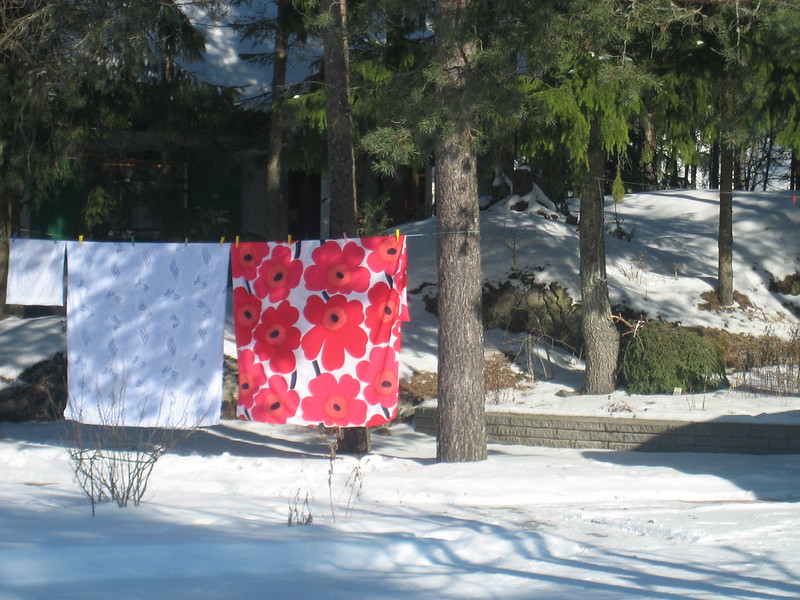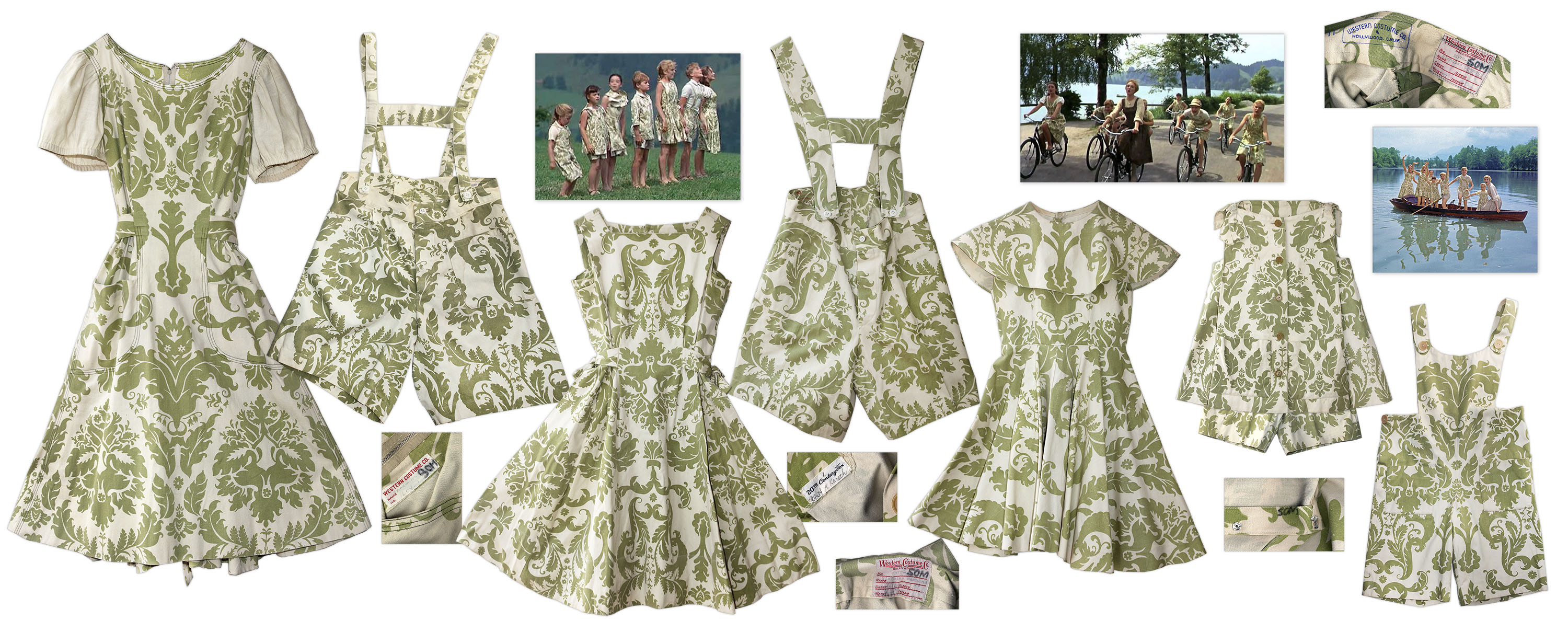I recently started sewing from patterns for the first time. Until now, I just made clothes based on measurements and tried them on along the way. It is especially easy for me to do that with alterations. Since most of my garment sewing was done with charity/thrift shop finds that needed tweaking or old lesser pieces from my wardrobe which I wanted to reinvent, that approach suited me fine. But it is also limiting. After all this practice it was time to take the leap to paper sewing patterns. I bought a few patterns and have decided to that this spring I’ll be sewing clothes.

Why Upcycled Bedding?
Because I am new to this and fabric is expensive, I think it would be good to try it out first with old sheets. Of course, we decluttered and got rid of our old sheets when we moved last year so that means I’ll use someone else’s old sheets. It’ll be a great fabric to practice my skills of cutting out pattern pieces and seam allowance.
I think I’m not alone that I gasped audibly (in a hospital waiting room, no less) when I saw on the news that Dame Kiri Te Kanawa had her skirt for the 2019 BBC Singer of the World awards custom made from a floral bedsheet. Her love of and search for a hydrangea print led her to the printed bedsheet and it turned out beautifully.

Best Bedding to Use
The best items to use when sewing clothes from upcycled bedding are the flat sheets and duvet covers. Ideally, cotton, but these days it is often a cotton & poly blend. Though fitted sheets work, often the yield of usable fabric is less because pre-loved fitted sheets have the most wear and tear. They’re more likely to fray around the elastic corners and have a greater potential for stains. Even if it is clean and unfrayed, if the fitted sheet is old, the fabric’s memory of being creased at the corners may be hard to erase. In terms of stains, shopping with a black light flashlight allows you to see stains that may not be visible under the florescent store lighting. Or you can decide ignorance is bliss and give it a long cycle in the washing machine when you get home. Emily Retro has a great blog post describing best options for sourcing vintage and pre-loved bed sheets.
In an ideal world on my dream visit to a thrift store or charity shop, I find a set of Marimekko sheets (heck, even a flat sheet or a duvet cover would make my day – honestly, even a pillowcase). And since it’s my fantasy, I also find a couple cotton French tablecloths because we are big on tablecloths at my house. These are pieces with lasting power. My parents had a set of Marimekko sheets decades ago and when I cleared out their house, one pillowcase still remained. The larger-than-life print feels both enthusiastic and unapologetically cheerful, while being classic somehow. That’s also what I love about Emilio Pucci. Years ago, I thrifted a twin duvet cover in a pink and white Pucci-like design. We used it in the nursery when Optimus was a baby and whichever parent was on duty slept on a single bed in there. So, not only is it beautiful, it reminds me of a precious time when our whole world fit into one room. That duvet cover may turn into a dress if I find the right pattern for the fabric’s vibe. We only use flat sheets on our double-sized guest bed, which means I may have a random flat sheet from a set floating around. I gave most of the sheets from my parents’ house away. In the States this past Autumn, I bought two sets of twin-sized Peanuts Christmas sheets for the kids’ beds. They came with flat sheets, so with two of them in the same print I plan to sew two duvet covers. I’m still looking for the right b-side fabric though. Because of the print and seasonal element of that particular sheet set, I don’t think it is suited for apparel, but that doesn’t mean other sheets aren’t ready to be transformed from linen closet to street style.

Bedding to Fabric
I researched what sheet and duvet cover sizes are (and will add them at the end of this post). There is a slight difference between US and European sizing, but for this purpose it isn’t meaningful. With 60–65 inches width for twin flat sheets (and wider as you go up bed sizes), you achieve the standard width of a fabric yard right there. Generally speaking, each twin/single flat sheet equals 2 yards of fabric, with a smidge extra. For a full/double flat sheet, you would surely get 2 yards out of it and with the extra width have a bit more, though it depends if it is patterned and what you are sewing with it.
Where you get the most fabric is with duvet covers and king flat sheets. Duvet covers double the yardage. For a twin duvet cover, you’d have 4 yards of fabric. A solid color double duvet gives you 4 yards, plus another two 1/2-yard sections. If the duvet is print, you’d still have that amount of fabric, but how usable it is depends on your what you are sewing with it. With just over 100 inches for length and width, depending on pattern and your sewing project, you could get 2 1/2 yards (at 50in wide) from a king flat sheet.

Measurements
These numbers aren’t perfect because different manufacturers and regions may have their own standard sizing. I looked at several websites and combed through product pages to take note of sizes then averaged it out, so hopefully this is close to accurate. The width of flat sheets varies 4–5 inches (around 10cm). But this gives you an idea. Here is a list of the sizes:
Cot/Crib/Twin/Single
- Standard Cot/Crib Sheet (Fitted): 25.5x51in / 65x130cm
- IKEA Cot/Crib Sheet (Fitted): 27.5x55in / 70x140cm
- IKEA Cot/Crib (Duvet Cover): 43x49in / 110x125cm
- IKEA Day Bed Single (Fitted): 31.5×78.75in / 80x200cm
- IKEA Small Single (Fitted): 35×78.75in / 90x200cm
- Standard Twin (Fitted): 40x75in / 101.5×190.5cm
- Standard Twin (Flat): 70.75x102in / 180x260cm
- IKEA Twin/Single (Fitted): 35×74.75in / 90x190cm
- IKEA Twin/Single (Duvet Cover): 59×78.75in / 150x200cm
- Standard Twin (Duvet Cover): 68x86in – 72x96in / 135x200cm
- IKEA Medium (Flat): 59x102in / 150x260cm
- IKEA Large (Flat): 94.5x102in / 240x260cm
Double/Full/Queen
- Standard Double (Fitted): 55x75in / 140x190cm
- Standard Double (Flat): 85x100in / 216x255cm
- Standard Double (Duvet Cover): 80x80in / 200x200cm
- IKEA Double (Fitted): 53×74.75in / 135x190cm
- IKEA Double (Duvet Cover): 80x80in / 200x200cm
- Standard Queen (Fitted): 60x80in / 152x200cm
- Standard Queen (Flat): 95x105in / 241×266.75cm
- Standard Queen (Duvet Cover): 90x90in / 230x230cm
King/Super King
- Standard King (Fitted): 80x80in / 200x200cm
- Standard King (Flat): 105x110in / 275x275cm
- Standard King (Duvet Cover): 104x92in / 225x220cm
- IKEA King (Fitted): 60x80in / 150x200cm
- Standard Super King (Flat): 120x108in / 305x275cm
- Standard Super King (Duvet Cover): 102x92in / 260x220cm
- IKEA King (Duvet Cover): 95x92in / 240x220cm
- IKEA Super King (Fitted): 70x80in / 180x200cm

What About Curtains?
I couldn’t very well write about up cycling bedding into a dress without bringing up Maria Von Trapp and sewing apparel from old curtains. There is also a crafter online who has done it with IKEA curtains!
For curtains, there is more to consider when sourcing material because they are often lined. This can be beneficial if you want to also line your dress because it comes with coordinating lining-weight fabric, but for blackout curtains sometimes they are fused together and the weight can be cumbersome for a dress but even more challenging for the average sewing machine. Choosing the right needle and project for the curtain weight is essential.
As with bedding, I personally always prefer natural materials. There aren’t any surprises, they don’t melt under high heat, and they can usually take dye if stains require an over-dye of a darker color. But many fine jacquard curtains would be a synthetic or blend which has a lovely effect with a nice sheen. We bought inexpensive insulated curtains for our new house last year just to get us through the winter. They are nice enough, but not very insulated and certainly not our style. Also, they don’t work with the wall color we are putting up in there. But the fabric is thin enough and has a nice drape that I could turn it into a formal-style dress or skirt – or dare I say cape or coat. It is metallic and outlandish, but that’s kinda why it would be so fun. I’ll keep thinking about it and maybe have the confidence Maria did one day and go for it. Rest assured, there will NOT be matching outfits for my kids!

To upcycle is not only a second chance of use for something, but also an opportunity to create something no one else is likely to have. The element of vintage is fun too because these are not prints or designs we see anymore, plus those vintage cotton sheets are luxuriously soft like butter. I do have one vintage fitted sheet from my childhood, but I wouldn’t dare cut it up to make something from the fabric. It is my beloved Miss Piggy Pig Follies sheet. There are some on eBay too if you’re interested.
What upcycled fabric have you worked with? Did it work out? What did you make? I’d love to hear all about it!

When my daughter and her husband were first dating, he looked at the curtains in her house and said that they would make a great Hawaiian shirt. Challenge accepted! I made him a Hawaiian shirt from the curtains and he’s had it fir over 15 years.
I LOVE this! Your daughter (and son-in-law) have great senses of humour.
I still have the Miss Piggy sheets! Childhood memories – Miss Piggy & Marimekko.
Amazing taste!